|
Fifth Dimension Catalog Contact Us |
|

|
Bed Rest and Bed Positioning |
Bed Positioning
Back to the Table of Contents
It is important to pay attention to the position you lie in, and when you are confined to bed, you may need help in positioning. During sleep, we unconsciously change position many times a night. This keeps muscles moving and stops cramping, stimulates blood circulation and prevents skin breakdown.
In our skin care section, we talk about bedsores and how they are caused by excessive or prolonged pressure on bony areas of the body. Circulation to that area gets cut off, cells die, and a pressure sore results. If you are going to be in bed for a long period of time, you will need to be particularly watchful to avoid skin breakdown, as well as muscle atrophy, or wasting. (Skin breakdown is also referred to as bedsores, pressure sores, or decubitis ulcers.) Atrophy is caused by prolonged disuse of a muscle. The muscle actually shrinks in diameter causing weakness and sometimes paralysis.
- There are three important steps you can take to avoid bedsores and muscle atrophy:
- 1. Careful selection of the surface you will be lying on;
2. Frequent change of position;
3. Adherence to a specially designed exercise program suitable for your needs and capabilities. - We'll discuss the first two steps in this section; exercise programs are covered in Exercise.
Selection of Bed
Choosing the right bed or mattress is very important for those of you who may have to spend much time in bed. Look for the following features when making a selection:
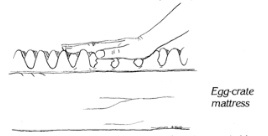 The mattress should be pliable enough to provide cushioning for your shoulder blades, hips, and spine, since these areas will be carrying most of your weight while you are lying in bed. An egg-crate mattress is one made of foam that eases excess pressure in these areas. Water and air mattress also are excellent in terms of pliability.
The mattress should be pliable enough to provide cushioning for your shoulder blades, hips, and spine, since these areas will be carrying most of your weight while you are lying in bed. An egg-crate mattress is one made of foam that eases excess pressure in these areas. Water and air mattress also are excellent in terms of pliability.
Air circulation is an important consideration in choosing a suitable surface. Plastic or other non-porous materials allow heat to build up next to your skin. This is an invitation for bacteria to gather, and also can cause chafing and raw skin. A sheepskin pad over the mattress will increase the circulation of air as well as provide extra cushioning.
- Positioning
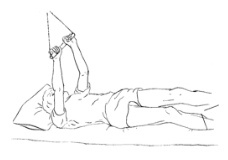 In addition to the mattress, the bed itself must be suited to your needs. You can rent hospital beds for use at home. These are particularly helpful because they can be adjusted to a variety of positions for eating, resting, and sleeping. The entire bed can be raised to assist your family in repositioning you, without strain for either of you.
In addition to the mattress, the bed itself must be suited to your needs. You can rent hospital beds for use at home. These are particularly helpful because they can be adjusted to a variety of positions for eating, resting, and sleeping. The entire bed can be raised to assist your family in repositioning you, without strain for either of you.
You may remember seeing other bed attachments in the hospital, which can also be rented. For example, folding side rails can be a great help when you wish to turn from side to side. An overhead trapeze will give you much better leverage when repositioning yourself or when getting out of bed.
Repositioning
Back to the Table of Contents
Frequent change of position is the second means of preventing bedsores and muscle wasting. If you are unable to turn over by yourself, it is important that your family helper understands the need and techniques for frequent repositioning --at least every two hours is a good rule of thumb.
Having a pull or draw sheet placed under you will greatly help another person turn you over. He or she folds a large sheet in half twice, forming a band slightly wider than the distance between your hips and your shoulders. Then you turn to one side, and your helper rolls the band up halfway and places the rolled part next to you (A). Then you turn back over the rolled part and onto the pull sheet, which should be under the heaviest part of your body, between shoulders and hips (B). Unrolling the pull sheet, your helper can now tug on the sheet rather than you, in helping you to turn over.
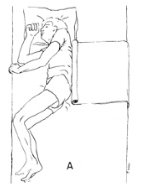
|
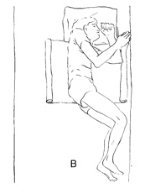
|
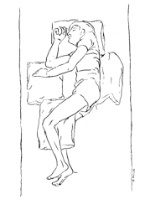
|
Small pillows or rolled-up towels can also be used to support your head, back, and upper leg when making a move. Your family helper should try to assist you to find positions that will be comfortable for as long as two hours. Remember, keep your knees and elbows slightly bent, not straight; most joints are most comfortable when slightly flexed. Use pillows to support the small of the back, the shoulders, and between the knees. Unlike other jointed parts of the body, your spine should be straight. |
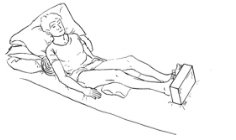
|
Positioning the feet is very important. If they are not flexed and exercised, and are allowed to remain limp for long periods, a condition known as foot-drop can develop. This is a condition caused by a shortening of the Achilles tendon and paralysis of the back muscles of the legs. Besides flexing exercises, props constructed from a cardboard box, sandbags, or wood can be used to keep your feet at right angles to your legs. |
Efficiency is important for your family helper. He or she can simplify the task of moving you by analyzing in advance the best way to make the move. If possible, the bed should be elevated to your helper's hip level, and all obstacles and causes of friction should be removed.
Standing as close to your bed as possible, your helper should roll or slide you into the desired position. Lifting can cause back strain and may not actually be necessary. For most efficient use of your helper's strength, he or she should stand with legs slightly apart, back straight, and use leg and hip muscles for most power and least strain while moving you.
By paying attention to all that we've discussed in this section, your stay in bed can be made most comfortable, and kept free from troublesome complications.
|
You are welcome to share this © article with friends, but do not forget to include the author name and web address. Permission needed to use articles on commercial and non commercial websites. Thank you. |
||